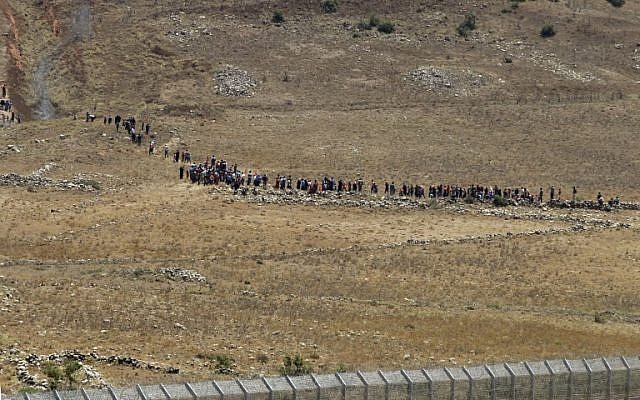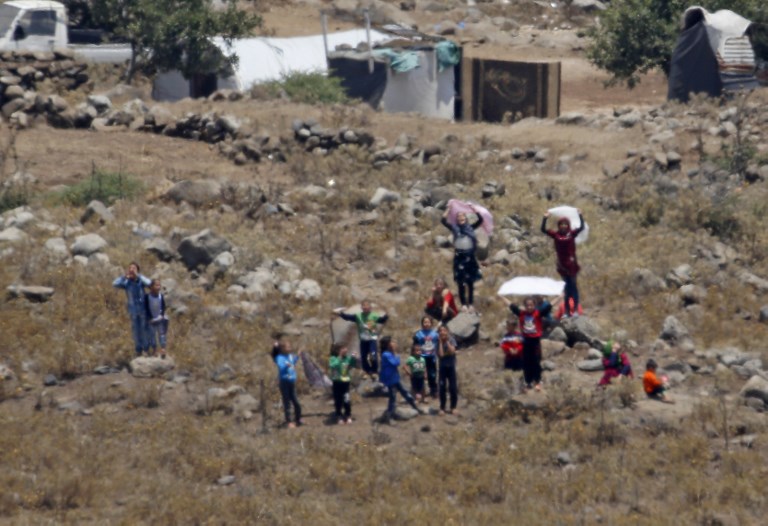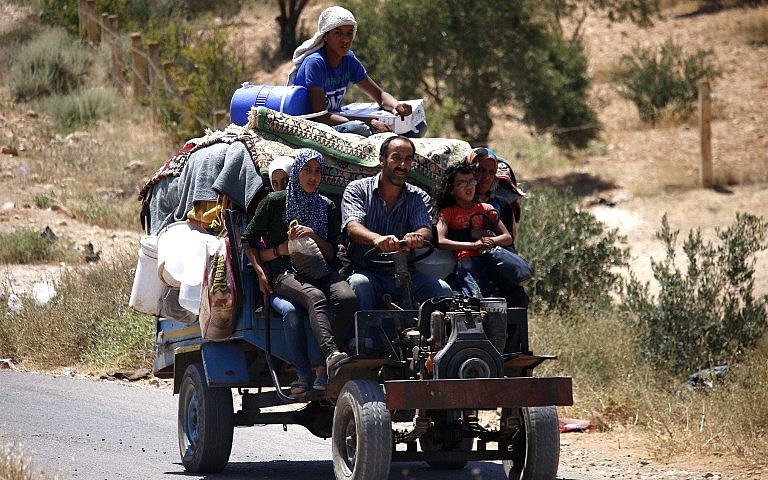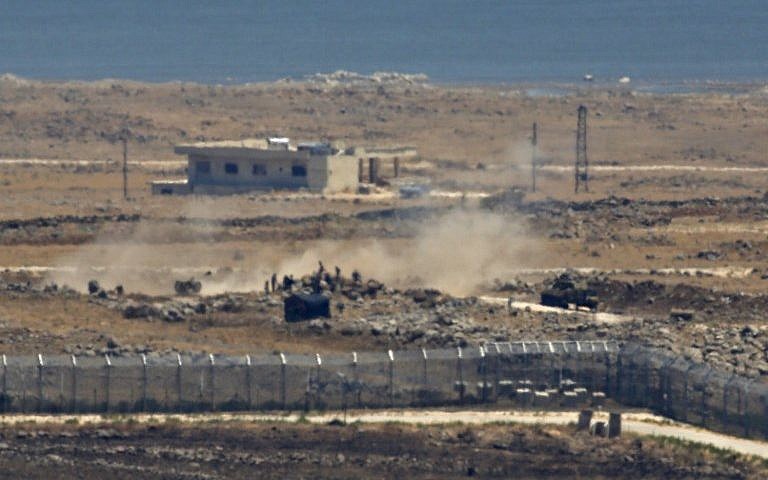Israeli troops do not directly interfere, but call on Syrian civilians to go back to their camp as regime offensive kills at least 10

Some 200 displaced Syrians approached the Israeli border on Tuesday, some of them waving white flags, in an apparent effort to reach out to the Jewish state for assistance as forces loyal to Syrian dictator Bashar Assad moved into the area as part of a military operation against rebel-held areas in the country’s southwest.
The refugees fled toward the border as a Russian airstrike on a nearby school being used as a shelter killed at least 10 civilians, according to a search and rescue team.
The Israel Defense Forces said it was aware of the situation on the border, but had not yet determined a need to take direct action.
Soldiers were seen calling for the approaching Syrians to move away from the border.

“Go back before something bad happens. If you want us to be able to help you, go back,” an Israeli officer told the crowd in Arabic. “Get a move on.”
The military confirmed that soldiers used bullhorns to tell approximately 200 Syrians to back away from the fence, but an IDF spokesperson said that this was due to concerns that they were approaching a live minefield near the border.
The officer was heard telling the Syrians that “we don’t want to hurt you,” according to Reuters.
“There were no out-of-the-ordinary incidents,” the IDF spokesperson said.
After a few moments, the Syrians dispersed, the army said, and they could be seen walking back toward a displaced persons camp in the village of Bariqa, near the border.
Since Assad’s renewed offensive against the largely rebel-held Daraa and Quneitra provinces began last month, Israel has expressed fears that Syrians from the areas might attempt to breach the border in an attempt to seek refuge inside the Jewish state.

Israeli officials have repeatedly stated that the country would not accept refugees, but it does provide humanitarian aid to those displaced by the fighting. The military detailed aspects of its Operation Good Neighbor program last year.
Since 2013, Israel has treated some 5,000 people injured in the civil war in field hospitals on the border and in public hospitals, mostly in northern Israel.
In addition, Israel also worked with international aid organizations to open a clinic along the border in 2017. Since its opening last year, the clinic has treated some 6,000 additional Syrian patients.
Israel has also insisted that the Syria abide by the 1974 Separation of Forces Agreement, which was reached following the Yom Kippur War the year before, that established a demilitarized zone along the border between the two countries. Syria is still formally at war with Israel.
Though the purpose of this demilitarized zone was to prevent further clashes between the two countries, by calling for a strict adherence to the ceasefire agreement, Israel has also established a de facto safe zone where fleeing Syrians can be spared from the Assad regime’s offensive, to a certain degree.
On Friday, Israel shot down a Syrian drone operating in this buffer zone, which Israel said amounted to a violation of the 1974 ceasefire agreement.
On Tuesday, monitors reported several Syrians killed in regime and Russian bombings near the frontier, including on a school in Ain el-Tineh, approximately 10 kilometers from the Golan security fence, in some of the closest airstrikes to the border so far.
Khaled Solh of the Syrian Civil Defense said the school building in the village of was being used to shelter families who have been forced to flee their homes amid the fighting.
Solh said at least 10 people were killed in the attack. Moaz al-Assaad, a photographer at the scene Tuesday, said he counted at least 20 wounded, including children.
In the west of the adjacent province of Daraa, Russian air raids killed one civilian near the village of Al-Aliya, the Syrian Observatory for Human Rights said.
“Since Tuesday morning, heavy Russian airstrikes and barrel bombs dropped by the regime have been targeting an area straddling Quneitra and Daraa,” Observatory head Rami Abdel Rahman said.
Hayat Tahrir al-Sham, a group led by Syria’s former Al-Qaeda affiliate, is present in that area, he said.
In Quneitra on Monday, rebels in at least five towns raised the national flag, seeking a similar agreement with the regime, Abdel Rahman said.
“Rebel factions in these towns have stopped fighting to avoid bombardment and destruction,” he said.
On Monday, Syrian rebels and government forces clashed over a reconnaissance point near the frontier with Israel, with government forces bombing villages and rebel positions around Tel al-Haara, the Observatory said.

Tel al-Haara overlooks the Golan Heights, which Israel captured from Syria in the 1967 Six Day War and later declared sovereignty over, and was the site of a Syrian reconnaissance base until opposition forces seized it in 2014 in the ongoing civil war.
Since June 19, government forces have seized towns and villages from rebels in southwest Syria, at the borders with Israel and Jordan, and recaptured the city of Daraa, the birthplace of the 2011 revolt against Assad.
The government now controls the main border crossing between Damascus and Amman, a key artery for Syrian exports to Jordan and the oil-rich Gulf states farther south. Jordan closed the crossing in 2015 when it was seized by rebels.
Both Israel and Jordan have signaled their consent to the campaign, though Israel has said it will not accept the presence of Iranian forces or proxy forces along its frontier. Assad has depended on support from Iran and its Lebanese proxy, the terrorist group Hezbollah, to fight his war on local opposition forces and an Islamic State group insurgency that proliferated through the country mid-decade.
As reported by The Times of Israel
